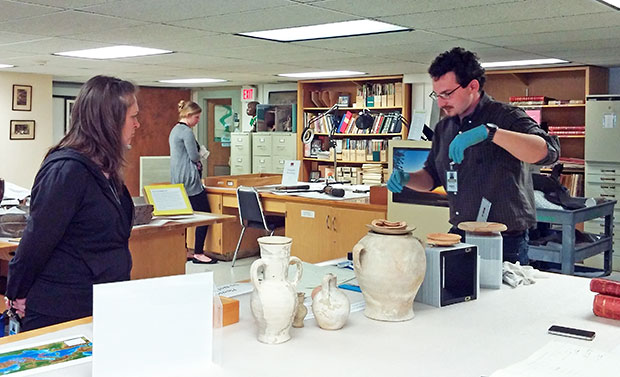2016 Ritzenthaler Museum Research Internship Award
Stephan Hassam was the 2016 Ritzenthaler Museum Research Internship Award Recipient. Through the spring he worked on the Milwaukee Public Museum’s (MPM) collection of Maltese material, acquired from a Mr. Eduardo Romeo Leopardi in the late 1960s at the behest of then director of the MPM, Stephan F. Borhegyi. The collection comprises ceramic, glass, metal, and skeletal elements which predominantly date to the Phoenician, Punic, and Roman periods of the Maltese archipelago’s history ca. 800 BC – 100 AD. Nearly all of the 167 objects in the collection were collected at an unknown date from funerary sites, most likely the rock-cut tombs that characterize Phoenician burial practices of the region. The size of this collection likely makes it one of the largest collections of Maltese material in the U.S. There is no information on the provenience of the materials, apart from that they were all collected on the island of Malta.

Reviewing the documentation of the MPM and further research on E.R. Leopardi and his family revealed information that allowed the formation of a preliminary hypothesis on the provenance of the objects in the collection since their deposition in the ancient times. The wife of E.R. Leopardi, Francoise Leopardi, belonged to the noble family of the De Piro’s. It was discovered that both her father and uncle inherited Phoenician and Punic materials from their father, Don Alessandro de Piro (1848-1898), indicating that the objects were probably collected by one or more of the De Piro family’s members in the nineteenth century.
Research on the collection itself consisted of acquiring metric data and photographs of the collection, focusing on the ceramic material. The collection of metric data, technical drawings of the ceramic vessels, and macroscopic analysis of the clay fabric of the ceramics was undertaken on a large portion of the collection. A close analysis of the ceramics will be followed by finding comparisons with similar materials found in situ in Malta, which will narrow the broad chronological ranges currently attributed to the vessels. Analysis of the fabric of the clay and research into Phoenician and Punic archaeological assemblages could also lead to the identification of associations between vessels within the collection, increasing their utility for educative and research purposes.
Further research on the collection will culminate in a thesis, and will continue in the following semesters. The lamps and some of the larger ceramic vessels will be analyzed macroscopically, drawn, and photographed. Faunal analysis of the skeletal material present in some of the vessels will also be carried out.
This project will lay the groundwork for any future research on the collection. The identification of vessel types, their associations, and faunal remains will contribute to the knowledge of Maltese-Phoenician funerary rites and burial assemblages in Malta. This research on the burial rites of the period will also provide an excellent narrative for the MPM to use the collection in future exhibits regarding ritual, burial, religion, and death.